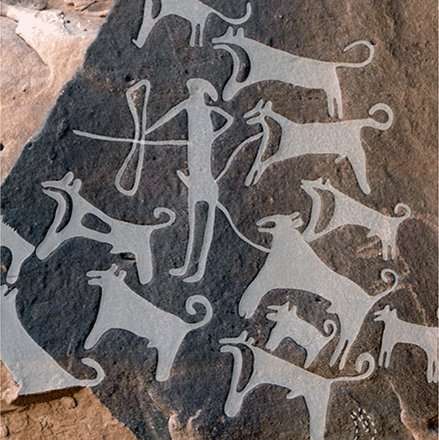Rock art at Shuwaymis appears to show two dogs leashed to a hunter. Credit: M. Guagnin et al., Journal Of Anthropological Archaeology, 5, 2017
(Phys.org)—A combined team of researchers from Max Planck University and the Saudi Commission for Tourism & National Heritage has documented what might be the oldest depictions of dogs by human beings. In their paper published in the Journal of Anthropological Archaeology , the team describes the wall engravings and the means by which they attempted to date them.
Prior research has suggested that humans first arrived in what is now Saudi Arabia approximately 10,000 years ago. Those first visitors were believed to be hunter-gatherers—researchers have found images of them carved into stone walls in the area. Prior research has also found evidence that people in the area domesticated animals and became herders approximately 7000 to 8000 years ago. They, too, have been depicted in stone etchings, and researchers have also found the bones of some of their livestock. Now, it appears that during the time between these two periods, people may have domesticated dogs and used them to hunt other animals for food. This new evidence is part of a collection of stone carvings the team has been studying at two sites in Saudi Arabia: Jubbah and Shuwaymis.
The stone carvings depict hunters, armed with bows, surrounded by dogs, some of which appear to be tethered to the waists of their human masters. It is not currently possible to directly date stone carvings, of course, so the researchers had to use other types of evidence. They noted the weathering of the rock, for example, which can be used as an approximate aging test. But more importantly, they noted the location of the engravings and the sequence of engravings in the area. Those depicting tamed, leashed dogs appear to occur in a general timeline from approximately 8000 years ago. If the age of the engravings can be confirmed, it would push back the earliest depiction of leashed dogs by approximately 3000 years.
The researchers note that the dogs depicted in the rock bear a striking resemblance to modern Canaan dogs, which still live a feral existence in the area. They also acknowledge that a lot more research is required before a consensus can be reached regarding the age of the engravings.
More information: David Grimm. Oldest images of dogs show hunting, leashes, Science (2017). DOI: 10.1126/science.358.6365.854
Maria Guagnin et al. Pre-Neolithic evidence for dog-assisted hunting strategies in Arabia, Journal of Anthropological Archaeology (2017). DOI: 10.1016/j.jaa.2017.10.003 , www.sciencedirect.com/science/ … ii/S0278416517301174
Journal information: Science
© 2017 Phys.org























